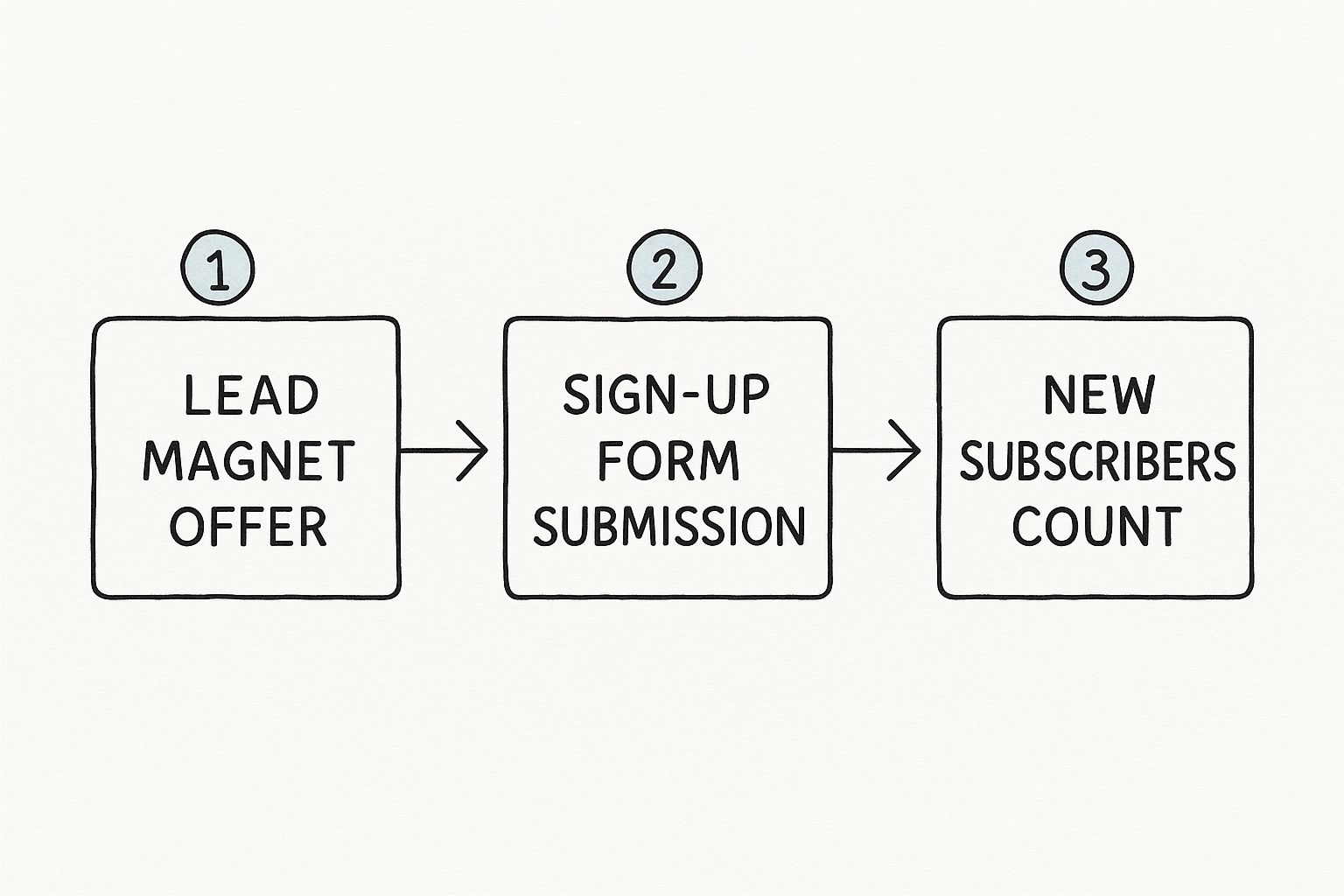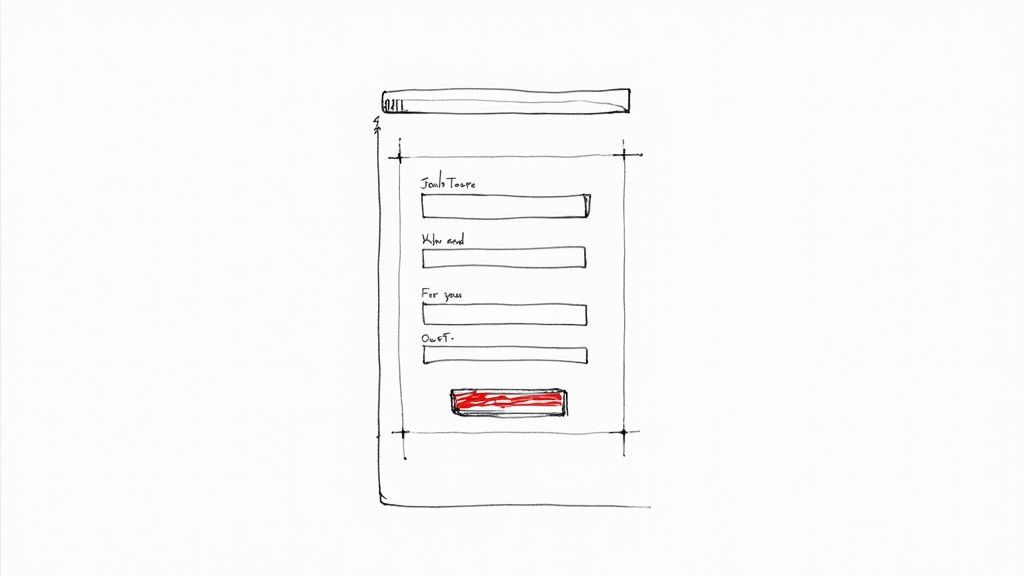Email marketing isn't just another item on your to-do list; it's one of the most direct and powerful ways to generate new business leads. It boils down to a simple, effective process: capture a potential customer's contact info, then nurture that relationship with valuable, targeted content that guides them toward becoming a customer.
Why Email Still Dominates Lead Generation
In a world of fleeting social media trends and unpredictable algorithms, email marketing remains a reliable workhorse for lead generation. It’s not just about blasting out messages. It’s about building a direct, owned communication channel with people who've actually said, "Yes, I want to hear from you."
This direct line is your own asset, immune to the whims of third-party platforms. It gives you complete control.
Unlike paid ads or social posts that are constantly fighting for a sliver of attention in a crowded feed, an email lands in a personal, private inbox. This creates a space for a one-to-one conversation that feels far more intimate and focused. When someone hands over their email address, they're giving you a signal of trust that's incredibly hard to earn through any other channel.
The Unbeatable ROI of Email
Let's talk numbers, because the financial case for email is impossible to ignore. For every single dollar you put into email marketing, you can expect an average return of $36. That figure alone crushes most other digital marketing tactics.
In some sectors, like retail and e-commerce, the returns are even more staggering, sometimes climbing as high as $45 for every $1 invested. It's no surprise, then, that nearly half of all marketers (48%) point to email as their most successful channel for bringing in new leads.
This incredible efficiency comes from a simple formula: low costs plus high conversion potential. You aren't paying for every click or impression. You're talking to an audience you’ve already built, making every email a chance to nurture, educate, and convert without draining your ad budget.
Here’s a quick breakdown of why email marketing is a powerhouse for lead generation:
Email Marketing Performance for Lead Generation
These metrics tell a clear story: if you're serious about generating high-quality leads, you need to be serious about email.
The Power of the First Impression
You only get one chance to make a first impression, and email absolutely nails it. A well-crafted welcome email is far more than a polite "hello"—it's a strategic move that cashes in on a moment of peak interest. Think about it: these initial emails boast an average open rate of nearly 64%. That's a massive jump from the typical marketing email average of 26.76%.
This first touchpoint sets the tone for the entire relationship. A strong welcome sequence can instantly validate a new lead's decision to sign up, deliver immediate value, and start guiding them down your funnel.
Picture this: someone lands on your site, downloads your latest guide, and instantly gets a personalized email with the resource and a warm welcome. That seamless experience confirms they made the right call and keeps your brand front and center in their mind. For a deeper dive on creating these crucial entry points, check out our guide on building high-converting landing pages.
Building Relationships That Drive Action
Great lead generation isn't a one-and-done deal. It's about building trust over time, and email is perfectly built for this kind of nurturing. By using segmented campaigns and automated sequences, you can deliver content that speaks directly to a lead's specific problems and interests. This is how you gently move them from just being aware of your brand to seriously considering a purchase.
While this guide is all about email, it's always smart to understand the full toolkit available. If you want to see how different lead gen tactics work across various sectors, you can explore broader lead generation strategies for various industries.
Ultimately, it’s the consistent, personalized communication that email makes possible that transforms a name on a list into a loyal customer, making it an essential tool for any business looking for sustainable growth.
Building an Email List That Actually Converts
Let's get one thing straight: a massive email list means nothing if it's full of the wrong people. The goal isn't just to rack up subscribers; it's to build a list of people who are genuinely interested in what you have to offer and are likely to become customers. This means ditching the generic "subscribe to our newsletter" buttons for good.
The whole game hinges on a simple value exchange. You have to give something truly useful before you ask for their email. This is your lead magnet, and it's the key to attracting the right crowd.
Designing High-Converting Opt-in Forms
Your opt-in form is the front door to your email list. How it looks and where you put it can make or break your subscription rates. The trick is to make signing up feel like a natural, seamless part of their experience on your site.
You can't just slap a form anywhere and hope for the best. Different types of forms work for different situations. It's no surprise that list growth is a huge priority for marketers—in fact, 74.7% are actively trying to grow their subscriber base. Pop-ups are a crowd favorite, with 76.2% of marketers using them because they grab attention. But other formats like embedded forms (59.5%) and top bars (23.8%) are also incredibly effective.
Here are a few of the heaviest hitters I've seen work time and time again:
- Embedded Forms: These are the forms you see tucked right into your content, like at the end of a blog post. They feel less pushy because they're part of the natural flow of the page.
- Exit-Intent Pop-ups: Just as a visitor is about to bail on your site, this form appears. It’s a last-ditch effort to capture their attention, and it works—38.1% of marketers use this tactic to convert abandoning visitors into subscribers.
- Two-Step Opt-ins: Instead of showing the whole form at once, you start with a simple button, like "Download the Checklist." Once they click, the form appears. This plays on a bit of psychology: people are more likely to finish something they've already started.
To make sure your new leads get their goodies right away, you'll want to automate the process. Look for tools that offer direct integrating with email marketing platforms like My Emma. This kind of automation is what allows you to instantly deliver your lead magnet and kick off your welcome sequence without any manual work.
Creating Lead Magnets That People Actually Want
A killer lead magnet is the heart of a solid lead generation strategy. It’s the valuable thing you trade for an email address. Its success boils down to one simple question: how well does it solve a specific problem for your ideal customer?
A great lead magnet offers a quick win. It should be easy to consume and provide immediate value, proving that subscribing to your emails was a smart move.
Forget the generic, 50-page ebooks. Think more targeted and actionable. If you need a refresher on the basics, our guide on how to build a powerful email list from scratch is a great place to start.
Here are a few lead magnet ideas that consistently get results:
- Checklists: A simple, step-by-step guide to get something done. Think "10-Point Website SEO Audit Checklist." It's practical and immediately useful.
- Templates: Give your audience pre-made documents that save them time. This could be anything from social media content calendar templates to email outreach scripts.
- Exclusive Video Content: A short tutorial, a webinar replay, or an exclusive interview that they can't find anywhere else.
- Resource Guides: A curated list of the best tools, articles, or resources on a specific topic. You do the research so they don't have to.
The flow is straightforward: you offer a must-have lead magnet, a visitor signs up through your form, and your list grows with people who are already engaged.

This really drives home the relationship between the value you offer and the growth of your list. The better your lead magnet, the more effective your forms will be. At the end of the day, the quality of your lead magnet determines the quality of your leads. Simple as that.
How to Write Emails That People Want to Read

So, you got the lead. Congrats. But don't pop the champagne just yet—the real work is just starting. Your goal just shifted from getting a subscriber to getting a customer. It's time to write emails that don't just land in an inbox; they need to get opened, read, and clicked.
This isn’t about sending generic company updates. It's about building a real connection, one email at a time. The secret isn't some complex, mystical formula. It’s about being human, providing value, and having a clear strategy. Every single email is a chance to prove you know your stuff and guide that lead one step closer to solving their problem.
Mastering the Art of the Subject Line
Let’s be honest, before anyone reads your beautifully crafted email, they see the subject line. It’s the bouncer at the club door of your message, and it has about three seconds to convince someone to click instead of hitting delete. A boring subject line in a crowded inbox is a one-way ticket to the trash folder.
The trick is to find that sweet spot between curiosity, urgency, and personalization. You want to tease the value inside without giving away the whole story. Think of it like a killer movie trailer—it has to be compelling enough to make someone stop scrolling.
Small tweaks here can make a huge difference. The average subject line is around 44 characters, which seems to be the sweet spot for being informative without getting cut off. Want a simple hack? Just including the word "video" can boost open rates by 19% and click-throughs by an incredible 65%. People love visual content. And basic personalization, like adding the recipient's name, has been shown to bump opens from 15.7% to 18.3%. It's simple, but it works.
Crafting a Compelling Email Body
Once your subject line has done its job, the body of the email has to deliver. This is where you build trust and gently nudge your lead toward the next step. The best emails I've ever received never felt like a sales pitch; they felt like a helpful conversation.
Storytelling is your best friend here. Instead of just rattling off a list of product features, tell a story about how a real customer crushed a problem using your solution. We’re wired to connect with narratives, not spec sheets.
Here are a few tips I've picked up over the years for writing an email body that actually gets read:
- Make it scannable. Nobody has time for a wall of text. Use short paragraphs, bullet points, and bold text to make key info pop.
- Talk about "You," not "We." Your reader cares about their problems, not your company's achievements. Instead of "We just launched a new feature," try "You can now solve [problem] with..."
- Keep your voice consistent. Whether your brand is funny, formal, or super nerdy, let that personality shine through in every email. Consistency is what builds brand recognition and trust over time.
Key Takeaway: Your goal is to give value first, sell second. Educate, entertain, or solve a tiny problem. When you do that consistently, your audience will be much more open to hearing your pitch when the time is right.
If you’re still struggling to get replies even with great content, your whole approach might need a refresh. For a deeper dive, check out our guide on 7 top tips to get a 20% reply rate to your cold emails.
Designing a Call-to-Action That Converts
Every single email in your funnel needs a purpose, and that purpose is defined by your call-to-action (CTA). It’s the one, specific thing you want the reader to do next. Without a clear CTA, even the most amazing email is just a dead end.
Forget tired, vague phrases like "Click Here" or "Learn More." They're boring and don't inspire anyone to do anything. Your CTA needs to be specific and action-oriented, telling the reader exactly what they'll get when they click.
Here’s how to make your CTAs impossible to ignore:
Lead with a Strong Verb: Kick off your CTA with a powerful action word.
- Instead of: "Get the guide." -> Try: "Download Your Free Guide"
- Instead of: "Sign up." -> Try: "Start Your Free Trial"
Create a Little Urgency: Nudge people to act now with time-sensitive language.
- Example: "Reserve Your Spot Now—Only 10 Left!"
- Example: "Get 25% Off Before It's Gone."
Make it Stand Out: Your CTA button should be the most obvious thing in the email. Use a contrasting color that grabs the eye and practically screams "click me!"
- Initial Action: Lead grabs the SEO guide.
- Automatic Segmentation: The system instantly tags them as "Interested in SEO" and "Beginner Level."
- Targeted Follow-up: Instead of a generic welcome email, they get a custom sequence. The first email might share a case study on how a similar business doubled their organic traffic. The next could be an invite to a webinar on keyword research for beginners.
- Lead Magnet Topic: Group subscribers by the specific guide, checklist, or template they downloaded. Someone who wanted a "Social Media Calendar" has very different immediate needs than someone who snagged a "PPC Budget Template."
- Website Activity: Create a segment for anyone who has visited key pages, like your pricing page or a specific service page. A visit to the pricing page is a massive buying signal and deserves a completely different kind of follow-up.
- Engagement Level: Split your list into your biggest fans (those who always open and click) and those who've gone quiet. You can send exclusive offers to your engaged crew and run a targeted re-engagement campaign to win back the lurkers.
- Demographic Information: If you collect data like job title, company size, or industry, use it! A marketing manager at a tiny startup has completely different challenges than a sales director at a huge enterprise.
- Overly salesy or pushy words: Phrases like "Buy now," "Limited time offer," or "Click here" can sometimes raise red flags, particularly when you overuse them.
- Using ALL CAPS or excessive exclamation points!!!!: This is a classic spam tactic. Shouting at your audience is never a good look and signals low-quality content.
- Misleading subject lines: A subject line that promises one thing but delivers something else is a major breach of trust and a surefire way to earn a spam complaint.
- Click-Through Rate (CTR): This tells you how many people clicked a link in your email. It's a direct reflection of how compelling your content and CTA are.
- Conversion Rate: This is the big one. It tracks how many subscribers actually completed the goal after clicking, whether that was filling out a contact form, downloading a case study, or signing up for a demo.
- Lead Quality: Not all leads are created equal. Use your CRM and analytics tools to see which email campaigns are producing leads that eventually become paying customers.
A great CTA feels like the logical next step. After reading your valuable email, the reader should want to click because it's the natural conclusion to the conversation you've started. This is how you turn passive readers into active, engaged leads.
Using Smart Segmentation to Boost Relevance

Let's be honest: the days of blasting your entire email list with the same generic message are long gone. If you want your emails to actually generate leads and not just get deleted, you have to send the right message to the right person.
This is where smart segmentation comes in. It’s the secret to turning your broad, faceless email list into smaller, highly engaged groups who are genuinely interested in what you have to say. Instead of shouting at a crowd, you get to have a quiet, relevant conversation. That shift is what separates campaigns that kill it from those that just create noise.
Moving Beyond Basic Personalization
Personalization is way more than just dropping a [First Name] tag into your subject line. Sure, it’s a nice touch, but the real magic happens when you segment people based on their actual behavior. It’s about understanding what they've done and why they’re on your list in the first place.
The impact can be huge. Studies have shown that personalized emails can pull in transaction rates six times higher than generic ones. It just makes sense—a message that feels like it was written specifically for you is always going to be more powerful than a blanket ad.
To pull this off, you need to pay close attention to how leads are interacting with your brand. What blog posts are they clicking on? Which lead magnet got them to sign up? What pages on your website did they linger on? Every single action is a breadcrumb, a clue to their pain points and interests.
Segmenting Based on Behavior
Behavioral segmentation is easily one of the most powerful tools in your email marketing arsenal. It lets you build automated workflows that react to what a lead does in real-time, making your follow-up feel incredibly timely and helpful.
This is exactly what platforms like PlusVibe are built for. By tracking user activity, you can set up triggers that automatically sort leads into the right buckets.
Let's walk through a real-world scenario. Say you run a digital marketing agency and someone downloads your "Beginner's Guide to SEO."
See what's happening here? It’s not a hard sell; it’s a helpful conversation. You're delivering immediate value based on what they've told you they care about, building trust and positioning yourself as the go-to expert.
Practical Segments You Can Create Today
Ready to put this into action? Here are a few simple but powerful segments you can build right now to make your email marketing far more effective at generating leads:
By dividing your audience, you ensure that every single email you send has the best possible shot at resonating. You stop being another piece of marketing noise and start becoming a trusted resource.
Ultimately, smart segmentation is about creating relevance at scale. It lets you keep that personal, one-on-one feeling even as your list grows into the thousands, ensuring your lead generation efforts are always firing on all cylinders. This is how you build real relationships that turn into real revenue.
Keeping Your Emails Out of the Spam Folder
 Let's be honest. A brilliantly written email with a killer call-to-action is completely worthless if it never actually reaches the inbox. Email deliverability isn't just some technical "nice to have"—it's the bedrock of any email funnel that hopes to generate leads.
Let's be honest. A brilliantly written email with a killer call-to-action is completely worthless if it never actually reaches the inbox. Email deliverability isn't just some technical "nice to have"—it's the bedrock of any email funnel that hopes to generate leads.
If your messages consistently land in spam, you’re not just losing out on potential business. You're actively damaging your brand's reputation with every "send."
Inbox providers like Gmail and Outlook are getting smarter by the day. They analyze hundreds of signals to decide if your email is legitimate or should be banished to the junk folder. Your job is to send all the right signals, proving your messages are wanted and genuinely valuable.
Protecting Your Sender Reputation
Think of your sender reputation like a credit score for your email domain. Every single email you send either builds it up or tears it down.
A high score tells inbox providers you're a trustworthy sender, essentially giving your messages a VIP pass to the primary inbox. A low score? Straight to spam, do not pass Go.
So, how do you maintain a healthy reputation? It starts with using a professional email marketing platform. A tool like PlusVibe handles a lot of the technical heavy lifting for you, ensuring your emails are properly authenticated—a massive green flag for spam filters.
Consistency also matters. Sending 10,000 emails one day and zero the next looks suspicious. A steady, regular cadence is always better for building and maintaining trust with email services.
The Importance of Regular List Cleaning
An unkempt email list is one of the fastest ways to absolutely wreck your sender reputation. Every time you send to an invalid address, it results in a hard bounce. Rack up too many of these, and inbox providers will quickly flag your entire domain as spammy.
This is why regular list hygiene is completely non-negotiable.
You need to routinely scrub your list to remove inactive and invalid subscribers. Inactive subscribers are the folks who haven't opened or clicked your emails in a while (think 90-180 days). They're just dead weight, dragging down your engagement metrics and signaling to email providers that your content isn't hitting the mark.
A smaller, highly engaged list will always outperform a massive, unengaged one. Don't be afraid to say goodbye to inactive subscribers. It’s better for your deliverability and your lead generation results in the long run.
Platforms like PlusVibe come with built-in email validation features that help you identify and scrub these problematic addresses before you even hit send, protecting your reputation from the get-go.
Avoiding Common Spam Triggers
Spam filters have gotten much more sophisticated over the years, but they can still be sensitive to certain words and formatting choices that are common in sketchy emails.
Be mindful of the language you use, especially in your subject lines. Try to avoid:
Formatting matters, too. Emails that consist of just one giant image with very little text are often flagged. Spammers love this trick because it hides their text from filters. Always aim for a healthy text-to-image ratio. For a more detailed breakdown, you might want to review our guide on 7 proven strategies to prevent emails from going to spam.
Tracking the Metrics That Actually Matter
Once your emails are reliably hitting the inbox, the real work begins. The focus shifts to performance. But too many marketers get stuck on vanity metrics like open rates. While opens are a decent indicator of subject line performance, they don't tell you if your emails are actually generating leads.
You need to look deeper. Here are the metrics that truly connect your email efforts to real business results:
By focusing on these action-oriented metrics within a platform like PlusVibe, you can create a powerful feedback loop. You'll see which messages drive real action, allowing you to double down on what works and refine what doesn’t. This is how you turn your email strategy into a predictable engine for high-quality leads.
Common Questions About Email Lead Generation
Even with the perfect strategy on paper, you'll always run into questions once you start getting your hands dirty with email lead generation. It happens to everyone. Let's walk through some of the most common ones I hear to clear things up so you can move forward with confidence.
What’s a Good Open Rate for Lead Generation Emails?
This is the big one, and the honest-to-goodness answer is... it depends. A "good" open rate shifts depending on your industry, how warm your audience is, and the type of email you're sending. But if you need a number to aim for, a range of 15-25% is a healthy benchmark for most B2B and B2C campaigns.
Keep in mind, context is everything. Your welcome email should blow that number out of the water, often hitting 50% or more, because you've caught someone at their peak interest. If your regular campaign emails are consistently dipping below 15%, that’s a major red flag telling you to rethink your subject lines or scrub your contact list.
How Often Should I Email My Leads?
Finding the right email cadence is a delicate dance. You need to stay top-of-mind without becoming that annoying brand that clogs their inbox. There's no single magic number, but a great place to start is sending content or newsletters once or twice a week.
For brand new leads just entering a nurture sequence, you can be a bit more aggressive. I often recommend emailing every other day for the first week to really build that initial momentum. After that, you can ease off as they get more familiar with you. The real key is to watch your engagement metrics like a hawk. If your unsubscribes suddenly jump after you increase the frequency, you've found your audience's limit.
Pro Tip: Put your subscribers in the driver's seat. A simple preference center where they can choose how often they hear from you is a game-changer for reducing unsubscribes and keeping people happy.
Is It Better to Use a Single or Double Opt-In?
Ah, the age-old email marketing debate. A single opt-in is frictionless—someone fills out a form, and bam, they're on your list. This approach will almost always grow your list faster.
On the flip side, a double opt-in adds a confirmation step. The subscriber has to click a link in an email to verify they actually want to be there. This extra step guarantees you're building a much higher quality list full of genuinely engaged contacts. It also acts as a shield for your sender reputation by keeping fake or typo-ridden emails off your list.
For most businesses that are serious about generating high-quality leads, double opt-in is the way to go. It ensures you're talking to people who actually want to listen.
What If My Emails Are Going to Spam?
Watching your carefully crafted emails land in the spam folder is beyond frustrating, but it's usually a fixable problem. The first thing you should do is check on your sender reputation and make sure your domain authentication is set up correctly. From there, make it a habit to regularly clean your list, purging inactive subscribers and bouncing email addresses.
Another crucial move is to check your deliverability before you hit send. We've put together a guide on the 12 best email deliverability tools for 2025 reviewed that's worth a read. These platforms are designed to spot problems in your content or technical setup that could be flagging spam filters, allowing you to fix them and get your emails back into the primary inbox where they belong.
Ready to turn your email strategy into a powerful lead generation machine? With PlusVibe, you can automate your outreach, personalize every message, and ensure your emails always land in the primary inbox. Start generating more high-quality leads today with PlusVibe.














































.jpeg)


.png)























































